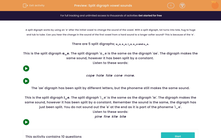A split digraph works by using an ‘e’ after the initial vowel to change the sound of the vowel. With a split digraph, tot turns into tote, hug to huge and tub to tube. Can you hear the change in the sound of the first vowel from a hard sound to a longer softer sound? This is because of the ‘e’.
There are 5 split digraphs; a_e, e_e, i_e, o_e and u_e.
This is the split digraph a_e. The split digraph 'a_e is the same as the digraph 'ae'. The digraph makes the same sound, however it has been split by a constant.
Listen to these words:
cape hate fate cane mane.
The 'ae' digraph has been split by different letters, but the phoneme still makes the same sound.
This is the split digraph i_e. The split digraph 'i_e' is the same as the digraph 'ie'. The digraph makes the same sound, however it has been split by a constant. Remember the sound is the same, the digraph has just been split. You do not sound out the 'e' at the end as it is part of the phoneme 'i_e'.
Listen to these words:
pine fine kite bite







